Buddhist monks lead lives characterized by simplicity, discipline, and deep spiritual practice. Their daily routines and principles offer valuable insights for those seeking a more mindful and fulfilling existence. This article explores the key aspects of monastic life, providing guidance on how to incorporate these practices into your own life.
Understanding Buddhist Monastic Life
Buddhist monasticism is a path chosen by individuals who wish to dedicate themselves fully to spiritual development. Monks renounce worldly possessions and desires to focus on meditation, ethical conduct, and wisdom. While the specifics can vary among different Buddhist traditions, certain core elements are consistent.
The Daily Routine of a Buddhist Monk
A typical day for a Buddhist monk is structured to promote mindfulness and spiritual growth. Here’s an overview of a monk’s daily schedule:
Early Morning
4:00 am – Wake-Up Call: The day begins early, often with the sound of a gong or bell. Monks rise from their simple dwellings to start their day in tranquility.
4:30 am – Meditation: The morning starts with a period of silent meditation, allowing monks to cultivate inner peace and focus.
5:30 am – Chanting: After meditation, monks gather in the temple to recite mantras and sutras, reinforcing their commitment to the path.
Morning Activities
6:30 am – Alms Round: Monks walk barefoot through nearby villages, collecting alms of food and money from laypeople. This practice fosters humility and gratitude.
8:00 am – Communal Meal: After returning from alms, monks partake in a communal meal, which is often their last for the day. Eating together strengthens community bonds.
Midday to Afternoon
9:00 am – Study and Practice: The late morning and early afternoon are dedicated to studying Buddhist texts, engaging in discussions, and practicing mindfulness.
1:00 pm – Rest: A period of rest or personal reflection helps monks maintain their well-being and deepen their practice.
Late Afternoon to Evening
3:00 pm – Community Service: Monks may engage in various community activities, such as teaching laypeople, participating in ceremonies, or maintaining the monastery grounds.
5:00 pm – Evening Chanting: The day concludes with another session of chanting, expressing gratitude and reinforcing spiritual commitments.
6:00 pm – Meditation: A final period of meditation helps monks reflect on their day and cultivate a calm mind before sleep.
Key Principles of Monastic Life
Beyond the daily routine, Buddhist monks adhere to several guiding principles that shape their way of life:
Simplicity
Monks live with minimal possessions, embracing simplicity to reduce distractions and focus on spiritual pursuits. This simplicity extends to their diet, clothing, and living arrangements.
Discipline
A strict code of conduct governs monastic life, including adherence to ethical precepts and participation in communal activities. This discipline supports personal growth and harmony within the monastic community.
Mindfulness
Constant mindfulness is cultivated through meditation and attentive living. Monks strive to be present in each moment, fostering awareness and insight.
Compassion
Acts of kindness and compassion are central to monastic life. Monks often engage in community service and teachings to support others on their spiritual journeys.
Incorporating Monastic Practices into Daily Life
While adopting the full monastic lifestyle may not be practical for everyone, certain aspects can be integrated into daily routines to enhance well-being:
Establish a Routine: Create a structured daily schedule that includes time for meditation, study, work, and rest. This balance promotes productivity and mindfulness.
Simplify Possessions: Evaluate your belongings and consider letting go of items that do not serve a meaningful purpose, fostering a sense of freedom and clarity.
Practice Mindfulness: Incorporate mindfulness into everyday activities, such as eating, walking, or commuting, to cultivate greater awareness and presence.
Engage in Community Service: Volunteer your time and skills to help others, fostering compassion and a sense of interconnectedness.
Limit Consumption: Be mindful of your consumption habits, whether it’s food, media, or material goods, to align with the monastic principle of moderation.
Benefits of Adopting Monastic Practices
Integrating elements of monastic life can lead to numerous benefits:
Enhanced Mental Clarity: Regular meditation and mindfulness practices can reduce stress and improve focus.
Deeper Spiritual Connection: Committing time to spiritual study and reflection can strengthen your sense of purpose and connection.
Improved Community Bonds: Participating in communal activities and service fosters a sense of belonging and fulfillment.
Simplified Living: Reducing material possessions and distractions can lead to a more peaceful and contented life.
Conclusion
Living like a Buddhist monk involves embracing simplicity, discipline, mindfulness, and compassion. While the full monastic lifestyle is a profound commitment, incorporating aspects of it into your daily life can lead to greater peace, purpose, and connection. By adopting these practices, you can cultivate a more mindful and fulfilling existence, drawing inspiration from the timeless wisdom of Buddhist monastic traditions.

